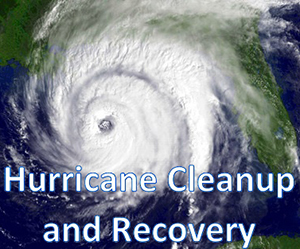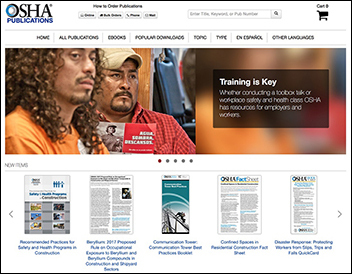 As outdoor temperatures drop and winter storms approach, employers should take measures to keep their employees safe. OSHA's Winter Weather webpage provides information on protecting employees from hazards while working outside during severe cold and snow storms. This guidance includes information on staying safe while clearing heavy snow from walkways and rooftops.
As outdoor temperatures drop and winter storms approach, employers should take measures to keep their employees safe. OSHA's Winter Weather webpage provides information on protecting employees from hazards while working outside during severe cold and snow storms. This guidance includes information on staying safe while clearing heavy snow from walkways and rooftops.
Monday, December 18, 2017
Winter Is Here: Be Prepared to Protect Workers from Weather-Related Hazards
 As outdoor temperatures drop and winter storms approach, employers should take measures to keep their employees safe. OSHA's Winter Weather webpage provides information on protecting employees from hazards while working outside during severe cold and snow storms. This guidance includes information on staying safe while clearing heavy snow from walkways and rooftops.
As outdoor temperatures drop and winter storms approach, employers should take measures to keep their employees safe. OSHA's Winter Weather webpage provides information on protecting employees from hazards while working outside during severe cold and snow storms. This guidance includes information on staying safe while clearing heavy snow from walkways and rooftops.
Redesigned Webpages Make It Easier to Find OSHA Training Resources
 Employers and employees can get information on job safety classes, trainers, tools, and 10-hour and 30-hour cards more easily using OSHA’s redesigned training webpage. The page offers links to resources on training requirements and resources, outreach training, OSHA Training Institute Education Centers, and Susan Harwood Training Grants.
Employers and employees can get information on job safety classes, trainers, tools, and 10-hour and 30-hour cards more easily using OSHA’s redesigned training webpage. The page offers links to resources on training requirements and resources, outreach training, OSHA Training Institute Education Centers, and Susan Harwood Training Grants.
New and Revised Fact Sheets on Silica Now Available
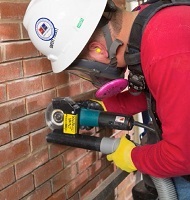 OSHA has released more than a dozen fact sheets that provide guidance on the respirable crystalline silica standard for construction. One fact sheet is an overview of the silica standard. The other fact sheets provide employers with information on how to fully and properly implement controls, work practices, and if needed, respiratory protection for each of the 18 tasks listed in Table 1— Specified Exposure Control Methods under the standard.
OSHA has released more than a dozen fact sheets that provide guidance on the respirable crystalline silica standard for construction. One fact sheet is an overview of the silica standard. The other fact sheets provide employers with information on how to fully and properly implement controls, work practices, and if needed, respiratory protection for each of the 18 tasks listed in Table 1— Specified Exposure Control Methods under the standard.
OSHA Training Institute Celebrates 25th Anniversary of Education Centers
OSHA Warns of Hazards When Using Roof Tarping in Hurricane Recovery Work
 Reinforced plastic tarps, commonly called “Blue Roofs,” provide temporary protection for the roofs of homes and other buildings damaged during severe weather such as a hurricane or tornado. When employees access roofs to install these tarps, they are at risk of falls, electrocutions, and other hazards. In a new fact sheet, OSHA recommends steps that employers can follow to help keep workers safe.
Reinforced plastic tarps, commonly called “Blue Roofs,” provide temporary protection for the roofs of homes and other buildings damaged during severe weather such as a hurricane or tornado. When employees access roofs to install these tarps, they are at risk of falls, electrocutions, and other hazards. In a new fact sheet, OSHA recommends steps that employers can follow to help keep workers safe.
Monday, November 20, 2017
New Silica Standard Requires Pulmonary Function Testing by Trained Technicians.
 The new Silica Standard requires that pulmonary function tests be performed by trained technicians.
The new Silica Standard requires that pulmonary function tests be performed by trained technicians. 1926.1153(h)(2)(iv)
A pulmonary function test to include forced vital capacity (FVC) and forced expiratory volume in one second (FEV1) and FEV1/FVC ratio, administered by a spirometry technician with a current certificate from a NIOSH-approved spirometry course;
Enroll in a NIOSH-approved spirometry course here: Rutgers School of Public Health - Center for Public Health Workforce Development
Compliance Date for Crane Operator Certification Requirements Set for November
 OSHA issued a final rule that sets November 10, 2018, as the date employers in the construction industry must comply with a requirement for crane operator certification. The final rule became effective on November 9, 2017. After issuing the final cranes and derricks rule in August 2010, stakeholders expressed concerns regarding the rule’s certification requirements. In response, the agency published a separate final rule in September 2014, extending by three years the crane operator certification and competency requirements. The additional one-year extension provides more time for OSHA to complete a rulemaking to address stakeholder concerns related to the Cranes and Derricks in Construction standard. Read the news release for more information
OSHA issued a final rule that sets November 10, 2018, as the date employers in the construction industry must comply with a requirement for crane operator certification. The final rule became effective on November 9, 2017. After issuing the final cranes and derricks rule in August 2010, stakeholders expressed concerns regarding the rule’s certification requirements. In response, the agency published a separate final rule in September 2014, extending by three years the crane operator certification and competency requirements. The additional one-year extension provides more time for OSHA to complete a rulemaking to address stakeholder concerns related to the Cranes and Derricks in Construction standard. Read the news release for more information
New Fact Sheets Available on Protecting Workers in the Shipyard and Maritime Industries
 OSHA has released four new fact sheets on protecting workers from common hazards found in the shipyard and maritime industries. The subjects covered by the four fact sheets are pedestal crane safety, housekeeping safety, fire and rescue in shipyard employment, and safe baggage handling.
OSHA has released four new fact sheets on protecting workers from common hazards found in the shipyard and maritime industries. The subjects covered by the four fact sheets are pedestal crane safety, housekeeping safety, fire and rescue in shipyard employment, and safe baggage handling.
Prevent the Spread of Seasonal Flu
OSHA's Seasonal Flu webpage offers information about how to reduce the spread of the flu in workplaces. It provides information on basic precautions that should be used by employers and workers in all workplaces, such as frequent hand washing and covering coughs and sneezes with a tissue. OSHA provides additional precautions that should be used in healthcare settings, such as strictly following infection control practices; using gloves, gowns, and other protective equipment to reduce exposures; and encouraging sick workers to stay home.
Thursday, October 19, 2017
Center for Public Health Workforce Development
 The Office of Public Health Practice has changed its name to the Center for Public Health Workforce Development. Since 1998, the Office of Public Health Practice has been responsible for the continuing education and workforce development activities of the Rutgers School of Public Health.
The Office of Public Health Practice has changed its name to the Center for Public Health Workforce Development. Since 1998, the Office of Public Health Practice has been responsible for the continuing education and workforce development activities of the Rutgers School of Public Health.
The Center for Public Health Workforce Development is a leading provider of programs, training, and technical assistance. Since our training center was initiated in 1977, we have trained over 750,000 individuals in occupational safety, environmental health, and public health topics. Technical assistance provided to local health departments included development of logic models for tobacco control teams for their evaluation plans, training to implement quality improvement plans, and evaluating the impact programs have on workplace practice.
The Center for Public Health Workforce Development will continue our outstanding programming to meet the needs of our partners. All of our existing projects will continue:
- Atlantic OSHA Education Center (OSHA)
- NJNY Hazardous Waste Worker Training Center (NIEHS)
- NYNJ Education and Research Center (NIOSH)
- Region 2 Public Health Training Center (HRSA)
We have invested thousands of hours to increase the capacity of the public health workforce, and our new name reflects the work we do. The Center for Public Health Workforce Development continues to be the leader in developing public health programs for our partners in New Jersey, New York and beyond!
Wednesday, October 18, 2017
New York City Council Approves new Construction Safety Training Bill
Workers will be required to complete a total of 40-55 hours of training. Training requirements take effect March 2018 and are phased in over a period of two years. Required courses include OSHA Construction Outreach Training, fall protection, and other training.
More information.
Silica Webpage Updated
 Information on silica hazards and related OSHA standards are now in one location on OSHA’s website. The updated silica page contains links to guidance on complying with OSHA’s silica standards in both construction and general industry and maritime, as well as information on silica sampling and analysis, health effects of silica exposure, and answers to frequently asked questions.
Information on silica hazards and related OSHA standards are now in one location on OSHA’s website. The updated silica page contains links to guidance on complying with OSHA’s silica standards in both construction and general industry and maritime, as well as information on silica sampling and analysis, health effects of silica exposure, and answers to frequently asked questions.
2018 National Safety Stand-Down to Prevent Falls to be held May 7-11
 The fifth annual National Safety Stand-Down to prevent falls in construction will be held May 7-11, 2018. Sponsored by OSHA, the National Institute for Occupational Safety and Health, and CPWR — The Center for Construction Research and Training, the weeklong outreach event encourages employers and workers to pause during the work day to talk about fall hazards and prevention. In past years, more than 1 million workers participated in events.
The fifth annual National Safety Stand-Down to prevent falls in construction will be held May 7-11, 2018. Sponsored by OSHA, the National Institute for Occupational Safety and Health, and CPWR — The Center for Construction Research and Training, the weeklong outreach event encourages employers and workers to pause during the work day to talk about fall hazards and prevention. In past years, more than 1 million workers participated in events.
OSHA Memorandum Outlines 30-Day Enforcement Plan for Silica Construction Standard
 Enforcement of OSHA’s respirable crystalline silica standard for construction went into effect on Sept. 23. The agency announced in a September 20 memorandum a 30-day enforcement phase-in to help employers comply with the new standard. Citations may be considered for employers not making any efforts to comply. For more information on silica hazards and OSHA’s standard, visit the Silica Final Rule webpage.
Enforcement of OSHA’s respirable crystalline silica standard for construction went into effect on Sept. 23. The agency announced in a September 20 memorandum a 30-day enforcement phase-in to help employers comply with the new standard. Citations may be considered for employers not making any efforts to comply. For more information on silica hazards and OSHA’s standard, visit the Silica Final Rule webpage.
Monday, September 18, 2017
OSHA’s Mobile-Friendly Publication on Training Requirements is Easy to Use on the Job
 OSHA's comprehensive guide to Training Requirements in OSHA Standards is a valuable reference to help employers, safety and health professionals, and training directors comply with the law and keep workers safe. However, at more than 250 pages, the printed version can be cumbersome to carry on some jobsites. That’s why the guide available in digital (MOBI and EPUB) formats; it can be read on a smartphone or tablet and easily searched for the standards that apply to specific industries or activities. Visit OSHA’s website to download a copy
OSHA's comprehensive guide to Training Requirements in OSHA Standards is a valuable reference to help employers, safety and health professionals, and training directors comply with the law and keep workers safe. However, at more than 250 pages, the printed version can be cumbersome to carry on some jobsites. That’s why the guide available in digital (MOBI and EPUB) formats; it can be read on a smartphone or tablet and easily searched for the standards that apply to specific industries or activities. Visit OSHA’s website to download a copy
What is an OSHA Intervention in Time of Emergency?
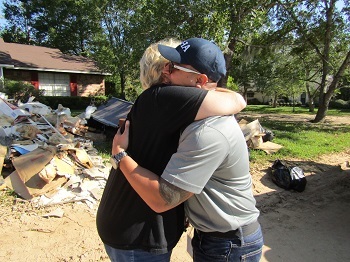 On September 9, a team of OSHA responders offered assistance to contractors, volunteers, and residents in Friendswood, Texas, who were recovering homes devastated by the floods from Hurricane Harvey. OSHA’s Simon Cabello and Justine Callahan provided volunteers from a local community church with personal protective equipment such as safety glasses and respirators for the work they were doing. The OSHA team focused on safety and health precautions, but offered help to local residents in other ways when needed. While doing their outreach, an elderly couple told inspectors Cabello and Callahan that they didn’t have flood insurance and they weren’t sure how to get information from the Federal Emergency Management Agency. The OSHA inspectors connected the homeowners with a FEMA representative, who met with them to assist in their recovery efforts.
On September 9, a team of OSHA responders offered assistance to contractors, volunteers, and residents in Friendswood, Texas, who were recovering homes devastated by the floods from Hurricane Harvey. OSHA’s Simon Cabello and Justine Callahan provided volunteers from a local community church with personal protective equipment such as safety glasses and respirators for the work they were doing. The OSHA team focused on safety and health precautions, but offered help to local residents in other ways when needed. While doing their outreach, an elderly couple told inspectors Cabello and Callahan that they didn’t have flood insurance and they weren’t sure how to get information from the Federal Emergency Management Agency. The OSHA inspectors connected the homeowners with a FEMA representative, who met with them to assist in their recovery efforts.OSHA Actively Engaged in Hurricane Harvey Recovery Efforts
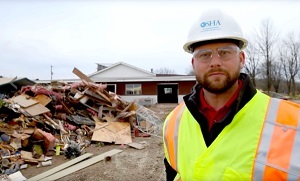 OSHA is working closely with local, state, and federal response partners to protect all workers involved in Harvey cleanup and recovery operations.
OSHA is working closely with local, state, and federal response partners to protect all workers involved in Harvey cleanup and recovery operations.
At FEMA’s request, OSHA staff joined the Joint Field Office in Austin, Texas, and is developing an incident-specific health and safety plan to protect workers during the cleanup and recovery operations. OSHA has been planning and conducting outreach with interagency partners and stakeholders by providing worker safety and health resources, such as the agency’s preparedness, response, and recovery webpages on hurricanes and floods.
To date, OSHA staff have conducted dozens of interventions in the Coastal Bend area to assist employers and workers in identifying unsafe or potentially unsafe working conditions. OSHA response teams have removed approximately 350 workers from hazards, and provided outreach at shelters and work camps where workers assembled and began preparing for recovery activities.
U.S. Labor Department to Provide Immediate Grants and Assistance for Hurricane Irma Recovery Efforts
In cooperation with state and local partners, the Department of Labor is setting aside funding and will be making grants to assist in disaster response efforts after Hurricane Irma. The Department has initially committed up to $40 million in Disaster Dislocated Worker Grant funding to Florida, Puerto Rico, and the U.S. Virgin Islands. The amount of total funding may increase as the needs and impacts on state and local partners are assessed following the hurricane.
OSHA is actively engaged with the National Response Team and the interagency response to the hurricane and flooding. It is working with the Federal Emergency Management Administration, the Environmental Protection Agency, the Department of Homeland Security, and other federal agencies to coordinate strategies for the recovery.
As the severity and extent of the damage becomes known, the Department will monitor activities and take additional actions as necessary. For more information on the Labor Department’s assistance to those recovering from Hurricane Irma, see the news release.
NIOSH to Hold Webinar on Occupational Safety for the Aging Workforce
 The National Institute for Occupational Safety and Health will host a webinar Sept. 28 from 1:00 to 2:30 p.m. ET on best practices for addressing occupational safety and health challenges posed by an aging workforce. The webinar will feature presentations on: research to address age differences at work; coaching to help workers manage and reduce the strain that chronic illness may present; and translating scientific knowledge on aging and its societal implications into policy-focused practice. For more information and to register, visit NIOSH's website.
The National Institute for Occupational Safety and Health will host a webinar Sept. 28 from 1:00 to 2:30 p.m. ET on best practices for addressing occupational safety and health challenges posed by an aging workforce. The webinar will feature presentations on: research to address age differences at work; coaching to help workers manage and reduce the strain that chronic illness may present; and translating scientific knowledge on aging and its societal implications into policy-focused practice. For more information and to register, visit NIOSH's website.
This webinar is the second annual installment of the Total Worker Health: Productive Aging and Work series. The first webinar, “Theory, Health Data, and Practical Solutions,” examined the concept of productive aging, designing aging-friendly workplaces, and hands-on methods organizations can take to meet workplace safety and health needs of workers of all ages.
New OSHA Publications Examines Cause of Fatal Fall
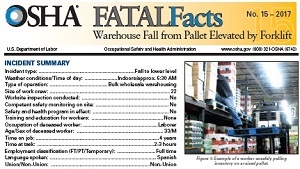 A new addition to OSHA's Fatal Facts series emphasizes the importance of using manufacturer-approved lifting equipment to prevent falls. Warehouse Fall from a Pallet Lifted by a Forklift, examines the root causes of an incident in which a worker died in a fall from an improperly raised pallet while pulling stock from elevated shelves. Fatal Facts describe cases in which there was a failure to identify and correct hazardous working conditions before they resulted in fatalities at the worksite.
A new addition to OSHA's Fatal Facts series emphasizes the importance of using manufacturer-approved lifting equipment to prevent falls. Warehouse Fall from a Pallet Lifted by a Forklift, examines the root causes of an incident in which a worker died in a fall from an improperly raised pallet while pulling stock from elevated shelves. Fatal Facts describe cases in which there was a failure to identify and correct hazardous working conditions before they resulted in fatalities at the worksite.
OSHA Urges Recovery Workers to Stay Safe in Areas Affected by Harvey
 As thousands of workers and volunteers courageously mobilize to help victims recover from the catastrophic storm damage in Texas and Louisiana, OSHA advises workers and those helping in recovery efforts to take proper safety and health precautions to avoid injury.
As thousands of workers and volunteers courageously mobilize to help victims recover from the catastrophic storm damage in Texas and Louisiana, OSHA advises workers and those helping in recovery efforts to take proper safety and health precautions to avoid injury.
Following a natural disaster, recovery and cleanup workers can be exposed to many dangers, including downed power lines, carbon monoxide and electrical hazards from portable generators, confined spaces, fall and struck-by hazards from weakened and damaged trees, mold, high water levels, toxic chemical exposure, and more.
OSHA has resources to help employers keep their workers safe when hurricanes and floods strike and during cleanup and recovery operations. For more information visit OSHA.gov or the Department of Labor’s Hurricane Recovery Assistance webpage.
Friday, August 18, 2017
Free US Constitution & Amendments course offered
 US Constitution Day will be commemorated on September 15, 2017, with 4-hr workshop “US Constitution & Amendments” in Somerset, New Jersey. This workshop is an excellent opportunity for OSHA Outreach Trainers to pick up pointers on how to more effectively deliver the “Introduction to OSHA” presentation. The facilitator for this workshop will be Michael Presutti.
US Constitution Day will be commemorated on September 15, 2017, with 4-hr workshop “US Constitution & Amendments” in Somerset, New Jersey. This workshop is an excellent opportunity for OSHA Outreach Trainers to pick up pointers on how to more effectively deliver the “Introduction to OSHA” presentation. The facilitator for this workshop will be Michael Presutti.This workshop is funded by OSHA through the Susan Harwood Program.
Click here for more information, and registration.
Office of Public Health Practice, Rutgers SPH YouTube Channel
 Please visit and subscribe to the Office of Public Health Practice, Rutgers SPH YouTube Channel for useful and informative online video content, regarding public health and safety.
Please visit and subscribe to the Office of Public Health Practice, Rutgers SPH YouTube Channel for useful and informative online video content, regarding public health and safety.
Trenching safety symposium webinar available online
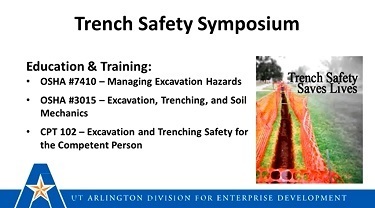 Now available online is a video of the June 27, 2017, Trench Safety Symposium webinar conducted by representatives from the National Utility Contractors Association, OSHA, and the University of Texas at Arlington. The symposium focused on ways to prevent trenching and excavation hazards in the construction industry. Visit OSHA’s trenching and excavation webpage for more information on working safely in trenches.
Now available online is a video of the June 27, 2017, Trench Safety Symposium webinar conducted by representatives from the National Utility Contractors Association, OSHA, and the University of Texas at Arlington. The symposium focused on ways to prevent trenching and excavation hazards in the construction industry. Visit OSHA’s trenching and excavation webpage for more information on working safely in trenches.OSHA publications made easier to find with revised webpage
OSHA’s publications webpage has been redesigned based on user data and feedback to better engage its many audiences and improve the way it functions. New and popular publications for specific industries or hazards are now easier to download and order. The webpage is formatted for all devices and platforms, from desktop monitors to smartphones.
Monday, July 3, 2017
Earn your Masters in Public Health (MPH) in Occupational Safety and Health at the Rutgers School of Public Health.
Rutgers School of Public Health is accepting students for the new MPH in Occupational Safety and Health. The program is designed to prepare graduates to effectively manage workplace safety and health hazards in diverse work environments. http://sph.rutgers.edu/departments/ENOH/index.html
Please contact Dr. Koshy for further information at koshyko@rutgers.edu
Please contact Dr. Koshy for further information at koshyko@rutgers.edu
OSHA to hold public meeting to solicit suggestions for strengthening the Voluntary Protection Programs
 OSHA will hold a stakeholder meeting July 17, 2017, in Washington, D.C., to discuss the future direction of the agency’s Voluntary Protection Programs (VPP). The discussion will include comments and suggestions from the public on potential avenues for action.
OSHA will hold a stakeholder meeting July 17, 2017, in Washington, D.C., to discuss the future direction of the agency’s Voluntary Protection Programs (VPP). The discussion will include comments and suggestions from the public on potential avenues for action.
OSHA is seeking to reshape VPP so that it continues to represent safety and health excellence, leverages partner resources, further recognizes the successes of long-term participants, and supports smart program growth. Some of the questions OSHA invites stakeholder input include:
- What can the agency do to enhance and encourage the efforts of employers, workers and unions to identify and address workplace hazards through the VPP?
- How can the agency support increased participation in VPP while operating with available resources and maintaining the integrity of the program?
- How can the agency modify VPP to enhance the efforts and engagement of long-term VPP participants?
- How might the agency modify Corporate VPP for greater leverage and effectiveness?
- How can the agency further leverage participant resources such as Special Government Employees?
The meeting will be held July 17, 9 a.m. to 5 p.m. in the Frances Perkins Building, U.S. Department of Labor, 200 Constitution Ave., NW, Washington, DC 20210. Those wishing to attend must register by July 10 at VPP Stakeholder Meeting Registration. Attendees can choose from several levels of participation in the discussion.
For those who may not be able to attend in person, a docket has been opened to receive comments. You can provide your input and/or read others’ comments here https://www.regulations.gov/docket?D=OSHA-2017-0009. The docket closes Sept. 15, 2017.
We anticipate hosting a second stakeholder meeting tentatively scheduled to occur in conjunction with the VPPPA National Conference the week of August 28th in New Orleans.
For more information about the stakeholder events, click here. We look forward to hearing from you about this important discussion.
Employers share their tips for keeping workers safe in extreme heat
Employers and safety professionals were asked how they are keeping workers safe from extreme heat. Below are a few examples of the responses received.
Land of Lincoln Goodwill Industries in Springfield, Ill., implements a buddy system within shifts so that workers can keep an eye on each other and report to their supervisor if they notice symptoms of heat illness. It is the company’s policy that new and/or transferred employees be acclimated to the environment by getting frequent breaks during their first two weeks on the job and during heat waves. The company also equips workers with cooling caps and bandanas, and provides earlier shifts and additional breaks, water and sports drinks on days when temperatures are expected to be especially high. Throughout the summer the company sends text messages/emails, and gives posters and toolbox talks to keep workers alert to the hazards of heat exposure.

Ballard Marine Construction uses canopies equipped with hoses to provide its workers with shade and cooling mist that protect them from the heat.
|
Ballard Marine Construction is a marine infrastructure and utility contractor serving international clients in the nuclear, hydroelectric, salvage, pipeline, and submarine cable industries. The company sets up portable shade canopies outside its dive control vans, with misting hoses woven throughout the frames to cover workers with a fine spray of water throughout the day. The company has also installed misters on its barges and used misting fans to keep its workers cool in high temperatures.
Granite Construction, one of the 25 largest construction companies in the U.S., uses a variety of methods to keep its workers safe from the heat. These include: providing each jobsite supervisor with a portable canopy sun shade; equipping workers with evaporative, cooling neck towels and shades that attach to the back of their hard hats to protect their necks from sun exposure; monitoring the OSHA-NIOSH heat safety app and following its recommendations; and conducting training sessions on heat exposure, how to recognize and treat heat-related illness, and proper hydration.
OSHA promotes safety in fireworks industry ahead of July 4 festivities
 With Independence Day celebrations approaching, OSHA is encouraging the fireworks and pyrotechnics industry to protect workers from hazards while manufacturing, storing, transporting, displaying and selling fireworks for public events. OSHA offers information on common hazards and solutions, including downloadable safety posters for workplaces.
With Independence Day celebrations approaching, OSHA is encouraging the fireworks and pyrotechnics industry to protect workers from hazards while manufacturing, storing, transporting, displaying and selling fireworks for public events. OSHA offers information on common hazards and solutions, including downloadable safety posters for workplaces.
OSHA and NIOSH team up to offer updated heat safety app
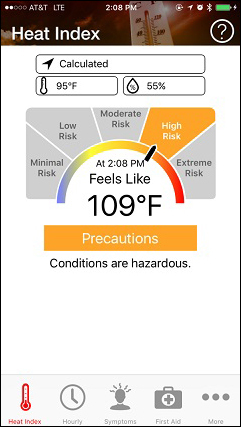 The National Institute for Occupational Safety and Health and OSHA have collaborated to update OSHA’s original Heat Safety Tool. The updated app, available for both Android and iPhone, provides a clearer user interface, while still providing the same information to help keep workers safe when working outdoors in hot weather. Extreme heat causes more deaths than any other weather-related hazard; each year more than 65,000 people seek medical treatment for extreme heat exposure.
The National Institute for Occupational Safety and Health and OSHA have collaborated to update OSHA’s original Heat Safety Tool. The updated app, available for both Android and iPhone, provides a clearer user interface, while still providing the same information to help keep workers safe when working outdoors in hot weather. Extreme heat causes more deaths than any other weather-related hazard; each year more than 65,000 people seek medical treatment for extreme heat exposure.
Employers should encourage workers exposed to hot and humid conditions to use the app to check the heat index and relevant protective measures. The app displays the heat index in the user’s location and shows the current risk level. The app also forecasts the hourly heat index throughout the entire workday, giving employers information they can use to adjust the work environment as needed to protect workers.
More than 450,000 users have downloaded the original app since it was launched in 2011. The original OSHA app will no longer function after September 30. To download the updated app and get more information on OSHA’s efforts to help protect workers from the heat, visit our heat campaign webpage.
Tuesday, May 23, 2017
Free webinars on preventing heat stress scheduled for May and June
New videos and infographics provide facts on falls
 Falls are the leading cause of death for construction workers, accounting for 350 of the 937 construction fatalities recorded in 2015. These and other facts about fall hazards are highlighted in new resources from OSHA that employers can use in their discussions with employees during the National Safety Stand-Down. Two videos have been posted on the Stand-Down homepage and a series of infographics can be downloaded from OSHA's Fall Prevention Campaign webpage. We also encourage posting of the new videos and infographics on social media using the hashtag #StandDown4Safety.
Falls are the leading cause of death for construction workers, accounting for 350 of the 937 construction fatalities recorded in 2015. These and other facts about fall hazards are highlighted in new resources from OSHA that employers can use in their discussions with employees during the National Safety Stand-Down. Two videos have been posted on the Stand-Down homepage and a series of infographics can be downloaded from OSHA's Fall Prevention Campaign webpage. We also encourage posting of the new videos and infographics on social media using the hashtag #StandDown4Safety.
Friday, April 21, 2017
NIOSH online network helps healthcare facilities address bloodborne pathogens and other hazards
 The National Institute for Occupational Safety and Health has established a web-based injury and exposure monitoring system available at no cost to healthcare facilities. This secure system enables participating facilities to analyze worker injury and exposure data that they already collect. Trends for traumatic injury and hazardous exposures are visualized using a chart function. The system allows facilities to track five common work-related injuries and exposures in healthcare: sharps injuries; blood and body fluid exposure; slips, trips, and falls; patient handling injuries; and workplace violence. Visit the OHSN webpage for more information and to begin the enrollment process.
The National Institute for Occupational Safety and Health has established a web-based injury and exposure monitoring system available at no cost to healthcare facilities. This secure system enables participating facilities to analyze worker injury and exposure data that they already collect. Trends for traumatic injury and hazardous exposures are visualized using a chart function. The system allows facilities to track five common work-related injuries and exposures in healthcare: sharps injuries; blood and body fluid exposure; slips, trips, and falls; patient handling injuries; and workplace violence. Visit the OHSN webpage for more information and to begin the enrollment process.Safety seminars available online
 Recordings of two recent training seminars are available to watch online. One is a symposium on ladder safety hosted by the OSHA Education Center at the University of Texas, Arlington. The other is a webinar on "Communicating with Workers about Hazardous Materials" hosted by the American Staffing Association as part of its alliance with OSHA.
Recordings of two recent training seminars are available to watch online. One is a symposium on ladder safety hosted by the OSHA Education Center at the University of Texas, Arlington. The other is a webinar on "Communicating with Workers about Hazardous Materials" hosted by the American Staffing Association as part of its alliance with OSHA.
OSHA releases three new publications on Process Safety Management
 OSHA has released three guidance documents to help employers comply with the agency's Process Safety Management standard. PSM is critically important to facilities that store highly hazardous chemicals. Implementing the required safety programs helps prevent fires, explosions, large chemical spills, toxic gas releases, runaway chemical reactions, and other major incidents. The new documents focus on PSM compliance for Small Businesses, Storage Facilities and Explosives and Pyrotechnics Manufacturing.
OSHA has released three guidance documents to help employers comply with the agency's Process Safety Management standard. PSM is critically important to facilities that store highly hazardous chemicals. Implementing the required safety programs helps prevent fires, explosions, large chemical spills, toxic gas releases, runaway chemical reactions, and other major incidents. The new documents focus on PSM compliance for Small Businesses, Storage Facilities and Explosives and Pyrotechnics Manufacturing.
Beryllium rule effective date delayed to allow for further review
 OSHA has announced a delay in the effective date of the Occupational Exposure to Beryllium rule, from March 21 to May 20, to allow for further review and consideration. The extension is in keeping with a Jan. 20 White House memorandum that directed the review of any new or pending regulations. This does not affect the compliance dates of the beryllium rule. For more information, see the news release.
OSHA has announced a delay in the effective date of the Occupational Exposure to Beryllium rule, from March 21 to May 20, to allow for further review and consideration. The extension is in keeping with a Jan. 20 White House memorandum that directed the review of any new or pending regulations. This does not affect the compliance dates of the beryllium rule. For more information, see the news release.
National campaign aims to prevent roadway worker deaths and injuries
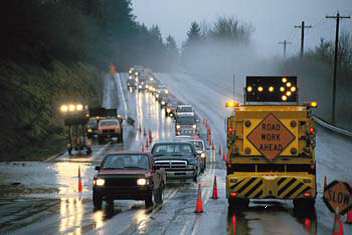 As road construction projects ramp up this spring, the Federal Highway Administration is partnering with OSHA, the American Traffic Safety Services Association, and other groups to encourage safe driving in work zones. The campaign, called National Work Zone Awareness Week, is an annual event set for April 3-7 this year. Tragically, 700 people, including 130 workers, were killed in crashes at roadway worksites in 2015. Many states and localities across the country will hold events to bring attention to these hazards and encourage safe driving around work zones.
As road construction projects ramp up this spring, the Federal Highway Administration is partnering with OSHA, the American Traffic Safety Services Association, and other groups to encourage safe driving in work zones. The campaign, called National Work Zone Awareness Week, is an annual event set for April 3-7 this year. Tragically, 700 people, including 130 workers, were killed in crashes at roadway worksites in 2015. Many states and localities across the country will hold events to bring attention to these hazards and encourage safe driving around work zones.
A national kick-off event is planned for April 4, at 10:30 a.m., at the Maryland state Randolph Road/Georgia Avenue Interchange Project. In addition, the Georgia Struck-By Alliance, which includes OSHA, will hold stand-downs at highway construction locations throughout Georgia this week to train workers on the dangers of distracted drivers and flying debris. For more information on the Georgia events, see the news release.
Monday, March 20, 2017
OSHA warns recovery workers, employers and public of storm cleanup hazards
 As residents in Kansas and Missouri recover from the damage caused by recent tornadoes and severe storms, OSHA urges caution during cleanup and recovery efforts. Workers, employers and the public should be aware of hazards they may encounter, and steps needed to stay safe and healthy. "Recovery work should not put you in the recovery room," said Karena Lorek, OSHA's area director in Kansas City. "Our main concern is the safety and health of the workers and volunteers conducting cleanup activities." OSHA representatives are available in hard-hit areas to communicate with emergency responders, provide advice and distribute educational resources to assist in a safe clean-up of damage. For more information, see the news release.
As residents in Kansas and Missouri recover from the damage caused by recent tornadoes and severe storms, OSHA urges caution during cleanup and recovery efforts. Workers, employers and the public should be aware of hazards they may encounter, and steps needed to stay safe and healthy. "Recovery work should not put you in the recovery room," said Karena Lorek, OSHA's area director in Kansas City. "Our main concern is the safety and health of the workers and volunteers conducting cleanup activities." OSHA representatives are available in hard-hit areas to communicate with emergency responders, provide advice and distribute educational resources to assist in a safe clean-up of damage. For more information, see the news release.
NIOSH releases sound app to help protect workers from hearing loss
 The National Institute for Occupational Safety and Health has developed a new, free mobile application for iOS devices that measures sound levels in workplaces. The NIOSH Sound Level Meter app displays real-time noise exposure data based on NIOSH and OSHA limits. The easy-to-use app can be particularly helpful to occupational safety and health trainers as they teach construction apprentices about noise hazards and the need for hearing protection. Visit the app webpage for more information.
The National Institute for Occupational Safety and Health has developed a new, free mobile application for iOS devices that measures sound levels in workplaces. The NIOSH Sound Level Meter app displays real-time noise exposure data based on NIOSH and OSHA limits. The easy-to-use app can be particularly helpful to occupational safety and health trainers as they teach construction apprentices about noise hazards and the need for hearing protection. Visit the app webpage for more information.
OSHA's $afety Pays Program shows employers how workplace injuries and illnesses impact their bottom line
 OSHA has updated the $afety Pays Program to include the most recent workers' compensation data from the National Council on Compensation Insurance. The program helps employers understand the impact of workplace injuries and illnesses on their company's profitability. OSHA provides many resources to help employers develop an effective safety and health program to improve safety and reduce costs. Benefits include reduced absenteeism, lower turnover and workers' compensation costs, higher productivity and increased morale.
OSHA has updated the $afety Pays Program to include the most recent workers' compensation data from the National Council on Compensation Insurance. The program helps employers understand the impact of workplace injuries and illnesses on their company's profitability. OSHA provides many resources to help employers develop an effective safety and health program to improve safety and reduce costs. Benefits include reduced absenteeism, lower turnover and workers' compensation costs, higher productivity and increased morale.
Nationwide Safe + Sound Week event being held June 12-18 to promote safety and health programs
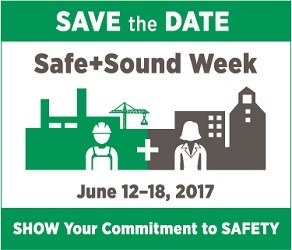 OSHA, the National Safety Council, the American Industrial Hygiene Association, the American Society of Safety Engineers, and the National Institute for Occupational Safety and Health a have announced June 12-18 as Safe + Sound Week. The event is a nationwide effort to raise awareness of the value of workplace safety and health programs. These programs can help employers and workers identify and manage workplace hazards before they cause injury or illness, improving the bottom line. Throughout this week, organizations are encouraged to host events and activities that showcase the core elements of an effective safety and health program--management leadership, worker participation, and finding and fixing workplace hazards. Visit the Safe + Sound Week webpage to sign-up for email updates on the event.
OSHA, the National Safety Council, the American Industrial Hygiene Association, the American Society of Safety Engineers, and the National Institute for Occupational Safety and Health a have announced June 12-18 as Safe + Sound Week. The event is a nationwide effort to raise awareness of the value of workplace safety and health programs. These programs can help employers and workers identify and manage workplace hazards before they cause injury or illness, improving the bottom line. Throughout this week, organizations are encouraged to host events and activities that showcase the core elements of an effective safety and health program--management leadership, worker participation, and finding and fixing workplace hazards. Visit the Safe + Sound Week webpage to sign-up for email updates on the event.
National Safety Stand-Down to Prevent Falls set for May 8-12
 Employers and workers are invited to participate in the fourth annual National Safety Stand-Down to prevent falls in construction, to be held May 8-12. Sponsored by OSHA, the National Institute for Occupational Safety and Health and CPWR — The Center for Construction Research and Training, the weeklong outreach event encourages employers and workers to pause during the work day to talk about fall hazards and prevention. Falls are the leading cause of death in the construction industry – accounting for 37 percent of fatalities industry-wide. In past years, more than 1 million workers participated in events. They have worked for public and private sector employees and small and large businesses. The event has recently expanded to include industries beyond construction. For more information on how to join in this year’s stand-down, access free training and education resources in English and Spanish, and receive a personalized certificate of participation, visit OSHA's webpage.
Employers and workers are invited to participate in the fourth annual National Safety Stand-Down to prevent falls in construction, to be held May 8-12. Sponsored by OSHA, the National Institute for Occupational Safety and Health and CPWR — The Center for Construction Research and Training, the weeklong outreach event encourages employers and workers to pause during the work day to talk about fall hazards and prevention. Falls are the leading cause of death in the construction industry – accounting for 37 percent of fatalities industry-wide. In past years, more than 1 million workers participated in events. They have worked for public and private sector employees and small and large businesses. The event has recently expanded to include industries beyond construction. For more information on how to join in this year’s stand-down, access free training and education resources in English and Spanish, and receive a personalized certificate of participation, visit OSHA's webpage.
Delay of beryllium rule effective date proposed to allow for further review
 OSHA is proposing to delay the effective date of the rule entitled Occupational Exposure to Beryllium, from March 21 to May 20 to allow for further review and consideration. The extension is in keeping with a Jan. 20 White House memorandum that directed the review of any new or pending regulations. It would not affect the compliance dates of the beryllium rule. Comments on the proposed delay will be accepted through March 13 and can be submitted at www.regulations.gov. For more information, see the news release.
OSHA is proposing to delay the effective date of the rule entitled Occupational Exposure to Beryllium, from March 21 to May 20 to allow for further review and consideration. The extension is in keeping with a Jan. 20 White House memorandum that directed the review of any new or pending regulations. It would not affect the compliance dates of the beryllium rule. Comments on the proposed delay will be accepted through March 13 and can be submitted at www.regulations.gov. For more information, see the news release.
Subscribe to:
Comments (Atom)




